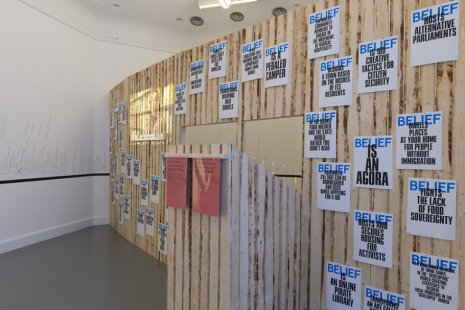From Tania Bruguera’s Herb Alpert Award application:
“In 2012 I was one of the group of 15 experts who shaped and drafted the first report on the right to freedom of artistic expression and creativity for the Office of the High Commissioner on Human Rights at the United Nations, the first of its kind. This document was voted and approved in May of 2013. I felt that all my life was building up to this moment. I felt useful to peers under political and social pressures and felt that difference could be engendered from the space of Art.”
“The goal of my work is not only to provoke ways of thinking, to spark reflection or to create a public forum to debate ideas that have been shown in their state of contradictions but to realize the possibility of working with Arte útil (art as a tool). Art is mostly accepted in its contemplative function, as an activation of the mind. What is pursued with Arte útil is rather to create an application for the double condition of the metaphor - literally, a "change of name," or a reframing whether it is in an art museum or the street or an educational institution. This is a strategy that works both in its practical implementation and in the symbolic realm. For example, my long-term project in the form of a school for political art ("Cátedra Arte de Conducta") dealt with the implications of the distribution of knowledge, simultaneously, as a concrete way to access reality and in its symbolic dimension, a concrete practice of an otherwise impossible imaginary. While recent traditions of artistic interventions in everyday practical life tend to strip them of their functionality (whether social or mechanical) so they can be re-located in the affect and the aesthetic perception, there are other older models (closer to my interest) where the reason for the creation is a re-configuration of reality through practical implementations.
With Arte útil I try to narrow the levels of disparities of engagement between art-informed audiences and the general public, as well as the historical gap between the language used in what is considered avant-garde and the language of urgent politics, science and other disciplines.
I created the
Arte útil Association (Useful Art Association) in January 2011 to provide a platform to meet, exchange ideas, and share strategies on how to deal with the issues of implementing the merger of art into society with other artists sharing the same research. The association works in an open manner through discussions, printed texts, actions groups, and public events, the latest being The Museum of Arte útil first exhibition (at the Van Abbemuseum in The Netherlands) and the creating of an archive and timeline with more than 200 case studies.”
“I divide my projects between long and short-term projects, ranging from a single day to several years. What determines the duration is the practical use of time to accomplish a specific goal, and the time lag between the presence of the work as an event and its delimitation or recognition as an artwork, its visibility as such, its potential to generate controlled meaning.
I chose long-term methodology when I try issues that evolve within social dynamics and, therefore, needs the use of 'social tempo' for production and for the implementation of the project. Long-term projects are best experienced when the audience incorporates into the process and the dynamics generated by the project, demanding a larger commitment from them than when experiencing art works on a more passive and purely artistic context. Very frequently these works are experienced in a fragmented way when the project is larger than the commitment from the audience or because of the natural progressive evolution of the project. They may also be seeing it out of context due to inaccessibility of the project or if seeing a posteriori.
I work with Arte de Conducta (behavior or conduct art). I do not work creating iconic revelations of the body but on socially engaged constructions of the collective. The use of Arte de Conducta assumes the location of the artistic in the social behavior as an artistic language and in its capability as generator of meanings. I'm interested in creating an environment that allows transforming 'the audience' into ‘an active citizen.’
In the work, "Tatlin's Whisper #5," for example, the audience is forced to recede to a political imaginary created by the media, one with which they have an anesthetized relationship. The images, not previously linked with a personal experience, are staged in order to transfer what was solely the knowledge of another political time and place into a personal memory. In this case, two mounted police entered the museum with the instructions to use their training on crowd control with the show's audience.
My work deals with the concept of political representation and its relationship with direct access to established structures of power. I'm interested in appropriating the resources of power to create power, to create through art political situations.”








